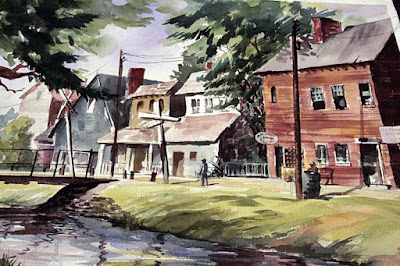HW for September 12
Comment either 1 or 2 (or both, if you really feel like it).
1. "How to Write a Blackwood Article" went through many published forms, but an earlier version of the story appeared with its companion piece "A Predicament" already in 1838. Do you think Poe borrowed from himself to later write "The Philosophy of Composition"? If so, how does tone and treatment of content differ from one to the other piece? Provide 1-2 short example(s).
2. In what ways do the "Minister's Black Veil" and "Shadow" seem alike or different? Do you see any reason for both of them being called "parables"? [Important: fyou just have to read, from the handout provided in canvas for the story, p. 188-192, or - ok - try an hearing experience, below]
1. "How to Write a Blackwood Article" went through many published forms, but an earlier version of the story appeared with its companion piece "A Predicament" already in 1838. Do you think Poe borrowed from himself to later write "The Philosophy of Composition"? If so, how does tone and treatment of content differ from one to the other piece? Provide 1-2 short example(s).
2. In what ways do the "Minister's Black Veil" and "Shadow" seem alike or different? Do you see any reason for both of them being called "parables"? [Important: fyou just have to read, from the handout provided in canvas for the story, p. 188-192, or - ok - try an hearing experience, below]



Hawthorne’s “Minister’s Black Veil” and Poe’s “Shadow” bare similar imagery and themes, but ultimately provoke a different reaction from the reader. Both “Minister’s Black Veil,” and “Shadow” have similar semantic fields. The language used to evoke the contrast between light and darkness is an ever-present element of both stories. Further, both stories contain funeral scenes which are revelatory and central to interpreting the overall message of the parable. Death, and more specifically the fear of the unknown, have fundamental roles of pushing the stories’ plots.
ResponderExcluirWhile both stories have identifiable similarities, they, from my interpretation, have different ways of expressing the overall message. In Hawthorne’s story, the object from which fear is emanating is clear from the start of the story. The minister’s black veil is central to expressing fear of the unknown, and by the end of the story, the reasoning behind wearing the veil remains unrevealed. Both the reader and townspeople are left with a feeling of discomfort and perpetual fear of what the veil represents. Poe’s story, however, sets the scene for most of the story; it is gloomy and scary and the seven companions are anxious. The shadow, which is the most important part of the story, isn’t in the scene until the very end. Further, I feel like Poe’s story has a sort of catharsis that Hawthorne’s doesn’t. In the voice of the shadow, the seven companions hear the voices of all their departed friends. To me, this almost seemed like a reason to stop fearing death and the unknown. Many people before have died and eventually they all will; while the shadow itself is dark and scary, the fact that it has a familiar voice almost seems comforting. Poe’s story didn’t leave me feeling uneasy in the way that Hawthorne’s did.
Finally, I feel like Poe’s story is more worthy of being deemed a parable than Hawthorne’s. I feel like Poe’s story is more universally relatable and the moral seems more clear cut. Hawthorne’s story, while it does indeed have a spiritual lesson, is much longer and open to more interpretation.
2. Both "The Minister's Black Veil" by Nathaniel Hawthorne and "Shadow" by Edgar Allen Poe could be considered parables due to their religious allusions and biblical association. Both stories are similar in that they both contain a main theme dealing with the presence of darkness, evil, or sin within a human community. Just as the minister bears the black veil as a concrete symbol of sin and evil within the story's puritan community, Poe intends the ominous shadow that rests among the men in the room. In addition, both stories parallel in the humans' reaction to the sudden visibility of sin and darkness within their respective communities. In "The Minister's Black Veil," the people adapt to shun and hide from the ominous black veil the minister bares, and similarly, the people in "Shadow" 'dared not steadily behold it, but cast down our eyes' (191). Both Poe and Hawthorne also use the common image of a dead person, with the community surrounding them, to accentuate the parallel between darkness or evil and imminent death. The physical emergence of darkness and evil in the faces of an otherwise ignorant community is what binds these two stories in similarity.
ResponderExcluir2. “The Minister’s Black Veil” and “Shadow” both contain many similar themes of death, darkness, and mystery. Both stories also revolve around one central mystery. In Poe’s story, this is the question of what the shadow comprises of, while in Hawthorne’s story, it is the question of why the Minister has donned, and refuses to take off, his black veil. The stories clearly have different endings, then, as Poe reveals that the shadow is comprised of “the well remembered and familiar accents of many thousand departed friends,” while Hawthorne leaves the mystery unsolved at the end of his story.
ResponderExcluirHowever, perhaps the resolution, or lack of one, does not create a large difference in the messages that both stories contain. Poe’s revelation is a confirmation of the presence of death in his story; it establishes death as a central theme and brings in questions about life after death, and the nature of sin and paradise. The suggestion behind the mysterious shadow in Poe’s story, is that these friends did not make it to paradise, evoking fear of the afterlife and creating the underlying suggestion of sin. Similarly, Hawthorne’s lack of a revelation allows the notion of sin to remain present in his story. By leaving the reason for the Minister’s donning of the black veil a mystery, Hawthorne creates the notion that the Minister committed a grave sin. This, in turn, brings up questions of the Minister’s afterlife as the story ends in his death.
While the two stories contain many similar themes and messages, I thought mystery to be crucial to both. Thus, I was unsure how they fit into the category of “parables,” as my definition of a parable would be a story with a clear moral message. Yet, from my interpretation, both stories are purposely left open-ended and ambiguous.
Response for Kevin Hautigan:
ResponderExcluirThe “The Minister’s Black Veil” and “Shadow” have two major similarities. The first similarity between the stories is that both utilize religious references to advance their main narrative. Hawthorne, in the “The Minister’s Black Veil,” refers to the veil worn by Reverend Hooper as something that throws, “… obscurity between him and the holy page… (p. 33).” This advances the idea that the veil represents some sort of wrongdoing by demonstrating how it affects Hooper’s connection to God. Poe, in “Shadow,” explains through the perspective of the narrator that before the ominous shadow came to be, there were things that were “spiritual” around (p.189). This draws a connection between the shadow and some sort of spiritual afterlife. The second similarity between the two stories is that they are both parables because both put forth lessons of a spiritual nature. “The Minister’s Black Veil” demonstrates that religious folk were all guilty of sin for judging Hooper for his form of penance. “Shadow” describes a spiritual afterlife highlighting that the living still keep the dead alive in their minds. However, the stories presented their main symbols differently. In “The Minister’s Black Veil,” Hawthorne shows Hooper in his veil early on and frames the story around his mysterious decision to wear the vestige. In “Shadow,” there is suspenseful buildup to the introduction of the shadow containing the dead, but it is not actually seen until the end of the story. This leaves the reader with less of an understanding of the symbol’s function.
Both the “Minister’s Black Veil” and “Shadow” contain a presence of darkness throughout the story. In the “Minister’s Black Veil,” Father Hooper carries a visible symbol of darkness that no one in the town could miss. The townspeople need to see the veil because they are supposed to be the recipients of its message. Likewise, in “Shadow” Poe states that “it was not unknown that the heavens wore an aspect of ill.” Both authors characterize darkness like clothing or a part of the outward appearance whether it be a veil or an aspect. The darkness of both of the tales centers on the context of religion. Father Hooper bears the cursed black veil in Hawthorne’s parable. Poe repeatedly contextualizes the terror of the time through an astrological or heavenly lense by invoking the Greek deities and spiritually significant places like Elysium. However, “Minister’s Black Veil” Father Hooper wears the veil like an omen of the darkness within the townspeople. Whereas in “Shadow” the darkness comes from death itself in the form of Oinos and his friends’ dead friend Zoilus. Both stories focus on the transition between life and death by comparing the earthly soul to the immortal soul. In “Shadow” death appears to the group “rested upon the brazen doorway.” Doorways symbolize the passing from one dimension into another. Both serve as parables because they provide the reader a message. Hawthorne and Poe chose to relay their message through ominous omens. Hawthorne uses the black veil to highlight the hypocrisy within the people of the town who only focus on appearances and reputations, superficial ideas that will not carry on to eternal afterlife. Poe frames his story during a plague, a type of tragedy that many describe as biblical in nature because of its symbolism. Given that the shadow sound like “many thousand departed friends,” it warns that no one can escape what is to come from the transition from life.
ResponderExcluir